 W
WThe 1908 Pattern Web Infantry Equipment was an innovative type of webbing equipment adopted by the British Army before World War I.
 W
W1937 Pattern Web Equipment was an item of military load-carrying equipment. It replaced the 1908 Pattern and 1925 Pattern—on which it was based—and was standard issue for British and Commonwealth troops from its introduction in 1937, throughout World War II, and in the post-war period until it was superseded by 58 pattern webbing.
 W
WThe Advanced Combat Optical Gunsight is a series of prismatic telescopic sights manufactured by Trijicon. The ACOG was originally designed to be used on the M16 rifle and M4 carbine, but Trijicon has also developed ACOG accessories for other firearms. Models provide fixed-power magnification levels from 1.5× to 6×. ACOG reticles are illuminated at night by an internal tritium phosphor. Some versions have an additional daytime reticle illumination via a passive external fiberoptic light pipe or are LED-illuminated using a dry battery. The first ACOG model, known as the TA01, was released in 1987.
 W
WThe AEC Militant was a post-war development by AEC of the AEC Matador artillery tractor used during World War II. Externally the most noticeable development was the cab, which was considerably enlarged. Unlike the Matador only 6-wheel versions were produced. 4-wheel versions are extant, but they are probably conversions and one is a Matador with a Mk1 Militant cab. Other changes included the fitting of a larger, 11.3-litre 6-cylinder, diesel engine and the use of a steel frame for the cab, rather than the ash (fraxinus) wood frame of the Matador. The Militant Mark 1 was produced in 6x4 and 6x6 form.
 W
WAn aiguillette, also spelled aguillette, aiglet or aglet, is a cord with metal tips or lace tags, or the decorative tip itself.
 W
WThe Balmoral is a traditional Scottish hat that can be worn as part of formal or informal Highland dress. Developed from the earlier blue bonnet, dating to at least the 16th century, it takes the form of a knitted, soft wool cap with a flat crown. It is named after Balmoral Castle, a royal residence in Scotland. It is an alternative to the similar and related (informal) Tam o' Shanter cap and the Glengarry bonnet.
 W
WThe Bardic Rail Signalling Lamp was the original name of a particular type of electric railway signalling handlamp made from 1962 by Bardic, Ltd. for use by rail and trackside workers. The lamp provided the colours red, green, yellow and white. Today, it refers to any lamp used for signalling that gives red, green, yellow and white colours that is in use by British railways to provide signalling.
 W
WThe Benghazi burner or Benghazi cooker was the nickname of an improvised petrol stove or brazier, used by British Army troops and their Commonwealth and Imperial allies in the Second World War, during and after the North African Campaign.
 W
WBlanco was a compound used primarily by soldiers throughout the Commonwealth from 1880 onwards to clean and colour their equipment. It was first used by the British Army to whiten Slade Wallace buckskin leather equipment, and later adapted to coloured versions for use on the cotton Web Infantry Equipment, Pattern 1908 webbing. Blanco became widely used throughout both world wars.
 W
WThis is a list of communications and reconnaissance equipment in use with the British Army. For more equipment in use with the British Army, see Modern equipment of the British Army.
 W
WBritish Army Dirigible No 1, christened Nulli Secundus was a Semi-rigid airship. First flown on 10 September 1907, it was Britain's first powered military aircraft.
 W
WThe uniforms of the British Army currently exist in twelve categories ranging from ceremonial uniforms to combat dress. Uniforms in the British Army are specific to the regiment to which a soldier belongs. Full dress presents the most differentiation between units, and there are fewer regimental distinctions between ceremonial dress, service dress, barrack dress and combat dress, though a level of regimental distinction runs throughout.
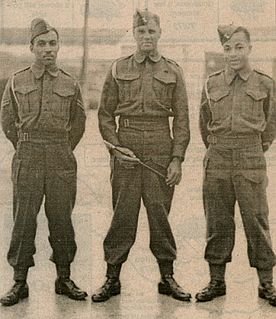 W
WBattledress was the specific title of a military uniform adopted by the British Army in the late 1930s and worn until the 1960s. Several other nations also introduced variants of battledress during the Second World War, including Australia, Canada, India, New Zealand, South Africa, and the United States of America and after the Second World War, including Argentina, Belgium, Norway, the Netherlands, and Greece.
 W
WThe Brodie helmet is a steel combat helmet designed and patented in London in 1915 by John Leopold Brodie. A modified form of it became the Helmet, Steel, Mark I in Britain and the M1917 Helmet in the U.S. Colloquially, it was called the shrapnel helmet, battle bowler, Tommy helmet, tin hat, and in the United States the doughboy helmet. It was also known as the dishpan hat, tin pan hat, washbasin, battle bowler, and Kelly helmet. The German Army called it the Salatschüssel. The term Brodie is often misused. It is correctly applied only to the original 1915 Brodie's Steel Helmet, War Office Pattern.
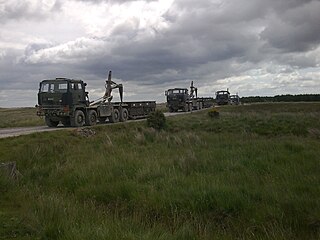 W
WThe Demountable Rack Offload and Pickup System (DROPS) is a family of logistics vehicles operated by the British Army, which consists of two vehicle types:Leyland DAF medium mobility load carrier (MMLC) Foden improved medium mobility load carrier (IMMLC)
 W
WThe Denison smock was a coverall jacket issued to Special Operations Executive (SOE) agents, the Parachute Regiment, the Glider Pilot Regiment, Air Landing Regiments, Air Observation Post Squadrons, Commando units, and other Commonwealth airborne units, to wear over their Battle Dress uniform during the Second World War. The garment was also issued as standard to the scout and sniper platoons of line infantry battalions.
 W
WDragon Runner is a military robot built for urban combat. At 20 pounds it is light enough to be carried and thrown. The original project was funded by the United States Marine Corps Warfighting Laboratory in conjunction with Carnegie Mellon University. It was designed at Carnegie Mellon University while the electronics and thermoplastic shell is developed and made by Automatika, Inc. Early development was conducted by the United States Naval Research Laboratory, including initial design, production and field testing.
 W
WA field dressing or battle dressing is a kind of bandage intended to be carried by soldiers for immediate use in case of wounds. It consists of a large pad of absorbent cloth, attached to the middle of a strip of thin fabric used to bind the pad in place. Field dressings are issued in sealed waterproof pouches to keep them clean and dry; the pouch can be torn open when required.
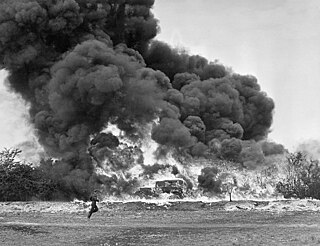 W
WA flame fougasse is a type of mine or improvised explosive device which uses an explosive charge to project burning liquid onto a target. The flame fougasse was developed by the Petroleum Warfare Department in Britain as an anti-tank weapon during the invasion crisis of 1940. During that period, about 50,000 flame fougasse barrels were deployed in some 7,000 batteries, mostly in southern England and a little later at 2,000 sites in Scotland. Although never used in combat in Britain, the design saw action later in Greece.
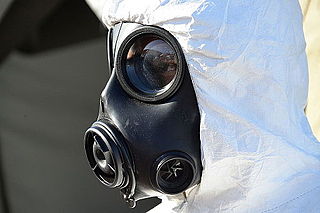 W
WThe FM12 CBRN Respirator is a military gas mask produced by Avon Rubber and in service with the British Armed Forces and various police forces.
 W
WThe General Service Respirator is a military gas mask designed to replace the previous S10 respirator for the British Armed Forces. It was designed by DSTL and Scott Safety in collaboration with the MoD, and was manufactured by Scott Safety. Avon Protection now manufacture the GSR from their factory in Melksham after winning the in-service support contract in 2019.
 W
WThe glengarry bonnet is a traditional Scots cap made of thick-milled woollen material, decorated with a toorie on top, frequently a rosette cockade on the left side, and ribbons hanging behind. It is normally worn as part of Scottish military or civilian Highland dress, either formal or informal, as an alternative to the Balmoral bonnet or tam o' shanter.
 W
WThe Helmet Steel Airborne Troops (HSAT) is a paratrooper helmet of British origin worn by paratroopers and members of airlanding units. It was introduced in Second World War by the British Army and was also used by other Commonwealth armies. It continued to be used in the post-war era – until the Falklands War, in the case of British airborne troops. As with the similarly shaped RAC helmet, it was initially manufactured by Briggs Motor Bodies at Dagenham.
 W
WThe Jackal or MWMIK or Mobility Weapon-Mounted Installation Kit is a family of vehicles designed and developed by Supacat Ltd at their factory in Honiton, Devon (UK) for use by the British Army and Royal Air Force Regiment. Supacat re-branded to SC Group in September 2015, the Supacat brand retained for the group's core defence business.
 W
WJavelin is a British man-portable surface-to-air missile, formerly used by the British Army and Canadian Army. It can be fired from the shoulder, or from a dedicated launcher known as Javelin LML: Lightweight Multiple Launcher. Capable of being vehicle mounted, the LML carries three rounds.
 W
WThe L118 Light Gun is a 105 mm towed howitzer. It was originally produced for the British Army in the 1970s and has been widely exported since, including to the United States, where a modified version is known as the "M119 howitzer".
 W
WThe Land Rover Wolf is a light military vehicle based on the Land Rover Defender introduced in 1994. The MoD designates the Wolf 90 as Truck Utility Light (TUL) HS and the Wolf 110 as Truck Utility Medium (TUM) HS. Where HS stands for High Specification. Land Rover calls it eXtra Duty (XD).
 W
WThe L number or weapon identity number system is a numerical designation system used for the type classification of British Armed Forces weapons and related stores. The L number in isolation is not a unique identifier; the L1 designation alone is used for a rifle and its corresponding bayonet, a machine gun, a tank gun, a sighting telescope, an anti-riot grenade, three separate rocket systems, a necklace demolition charge, a hand-thrown flare, and two separate types of user-filled demolition charge. Rather, the number is used in conjunction with a description, e.g. "Rifle, 7.62mm, L1A1" or "L1A1 7.62mm Rifle". The A number following the L number refers to the particular version of a piece of equipment; unlike some similar designation systems used by other countries where an A number is only used for subsequent versions of equipment, an A1 designation is always used for the first version to be officially adopted. Use of L numbers starts in the 1950s and an equivalent system for military vehicles is the FV series. On occasion, the number following the letter designation corresponds to the year that the item was adopted; for example, the rifle variant of the SA80 was first adopted in 1985 and was designated as the "L85A1 5.56mm Rifle".
 W
WThe Martini–Henry is a breech-loading single-shot lever-actuated rifle that was used by the British Army. It first entered service in 1871, eventually replacing the Snider–Enfield, a muzzle-loader converted to the cartridge system. Martini–Henry variants were used throughout the British Empire for 47 years. It combined the dropping-block action first developed by Henry O. Peabody and improved by the Swiss designer Friedrich von Martini, combined with the polygonal rifling designed by Scotsman Alexander Henry.
 W
WThe Medium Girder Bridge (MGB) is a lightweight, man portable bridge and can be assembled without help from heavy equipment. In addition, it is also a deck type, two-girder bridging system capable of carrying loads up to and including Main battle tanks (MBT).
 W
WThe Mk 6 helmet was the standard combat helmet of the British Armed Forces as well as another supplied helmet of the UN during peacekeeping operations. The Mk 6 replaced the Mk IV helmet in army service and the RAC helmet in naval service. The jump in MK numbers is thought due to the confusion surrounding the MK IV helmet using the MK V lining, introduced in 1959. The MK 6, introduced into service from the 1980s, is designed to accept modern ear protection, Bowman personal radios, and respirators. The helmet is manufactured by NP Aerospace, and is reported to have an "almost unlimited service life" by the manufacturer.
 W
WThe Mk 7 helmet is the current general issue combat helmet of the British Armed Forces supplied by NP Aerospace. Officially known as the GS Mark 7 combat helmet. It replaced the previous Mk 6A helmet and Mk 6 helmet, introduced in 2005 and 1982 respectively.
 W
WThe Mk III Helmet was a steel military combat helmet first developed for the British Army in 1941 by the Medical Research Council. First worn in combat by British and Canadian troops on D-Day, the Mk III and Mk IV were used alongside the Brodie helmet for the remainder of the Second World War. It is sometimes referred to as the "turtle" helmet by collectors, because of its vague resemblance to a turtle shell, as well as the 1944 pattern helmet.
 W
WMk IV helmet was a combat helmet used by the British Army in the 1960s to 1970s.
 W
WThis is a list of equipment of the British Army currently in use. It includes small arms, combat vehicles, aircraft, watercraft, artillery and transport vehicles. The British Army is the principal land warfare force of the United Kingdom, a part of British Armed Forces. Since the end of the Cold War, the British Army has been deployed to a number of conflict zones, often as part of an expeditionary force, a coalition force or part of a United Nations peacekeeping operation.
 W
WOsprey body armour is a system of body armour used by the British Armed Forces. The system is in its fourth iteration following extensive development and engagement with front line users.
 W
WA pace stick is a long stick usually carried by warrant officer and non-commissioned officer drill instructors in the British and Commonwealth armed forces as a symbol of authority and as an aid to military drill.
 W
WA pipe banner is a decorative flag for the Scottish Highland bagpipes. It is used when a piper performs at high-profile or State occasions where the pipe banner will be tied to the bass drone of her or his bagpipes. It is a rather expensive handmade item embroidered with bullion threads.
 W
WThe Royal Armoured Corps helmet is a combat helmet of British origin worn by Armoured Troops. As with the similarly shaped HSAT, it was initially manufactured by Briggs Motor Bodies at Dagenham. It was introduced in WW2 and was issued to commonwealth countries in the post-1945 era up to the Falklands War. The RAC helmets came with the same suspension and liner from the Brodie helmets and later the elasticated suspension and liner from the MkIII helmet. Many were converted to use as a Paratrooper Helmet.
 W
WThe ramped craft logistic (RCL) is a type of landing craft operated by 17 Port and Maritime Regiment RLC of the Royal Logistic Corps of the British Army. From the early 1980s onwards it was deployed to replace the RPL. One of their first roles was to provide logistical support during the setting up of the garrison in the Falkland Islands immediately after the Falklands War - this role was conducted by the two first of class, Arromanches and Antwerp. RCLs were originally procured for UK, Cyprus and Hong Kong, and are now only stationed at the military port at Marchwood, near Southampton, after the two based at the British base at Akrotiri, Cyprus were sold in 2014. They are slowly being withdrawn from service, as of 2015.
 W
WRed coat or scarlet tunic is a military garment used widely, though not exclusively worn, by most regiments of the British Army, Royal Marines, and some colonial units within the British Empire, from the 17th to the 20th centuries. The scarlet tunic continues to be used into the 21st century, with several armed forces of the Commonwealth of Nations adopting them as their full dress and mess dress uniforms. The term "redcoat" may have originated in 16th century Tudor Ireland as a derogatory term for the British, as British soldiers in Lord Lieutenant of Ireland's army wore red coats, the first time British soldiers collectively had a red uniform. The term was then brought to America and Europe by Irish emigrants.
 W
WThe Rigid Raider (RRC) is a series of fast raiding and assault craft made by RTK Marine, a subsidiary of Halmatic. They are primarily in service with two branches of the British Armed Forces: The Royal Navy and the British Army. Despite being among the smallest of the amphibious craft, the RRC is one of the most widely used due to its mobility and versatility. As such, the Rigid Raider often finds itself deployed in amphibious and riverine operations around the globe, in environments ranging from the Arctic to the tropics.
 W
WThe Service Respirator No. 6 (S6), also known as Respirator NBC S6 No. 1 Mark 1 was a protective gas mask issued to the British Armed Forces. It was developed in the 1950s and issued for general service from 1966 to 1986, when it was replaced by the S10. Currently, the S6 is not used by the British military.
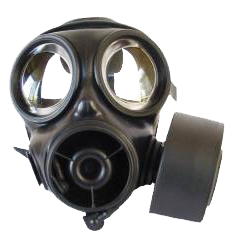 W
WThe S10 CBRN Respirator is a military gas mask that was formerly used within all branches of the British Armed Forces. Following the mask's replacement by the General Service Respirator in 2011, the S10 is now widely available to the public on the army surplus market.
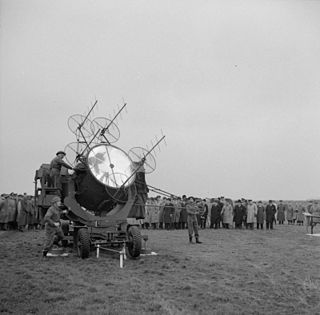 W
WSearchlight Control, SLC for short but nicknamed "Elsie", was a British Army VHF-band radar system that provided aiming guidance to an attached searchlight. By combining a searchlight with a radar, the radar did not have to be particularly accurate, it only had to be good enough to get the searchlight beam on the target. Once the target was lit, normal optical instruments could be used to guide the associated anti-aircraft artillery. This allowed the radar to be much smaller, simpler and less expensive than a system with enough accuracy to directly aim the guns, like the large and complex GL Mk. II radar. In 1943 the system was officially designated Radar, AA, No. 2, although this name is rarely used.
 W
WService Dress was the new style of khaki service dress uniform introduced by the British Army for use in the field from the early 1900s, following the experiences of a number of imperial wars and conflicts, including the Second Boer War. This variant of uniform continues to be worn today, although only in a formal role, as No. 2 Pattern dress.
 W
WValise Equipment, Pattern 1888 was a leather harness used by the British Armed Forces.
 W
WThe Spine Pad was an item of military kit used by the British Army when on service in hot climates. It was a piece of cloth, often quilted, designed to protect the spine from heat from the sun. The effect of the sun on the spine was thought to be dangerous in terms of developing fever and sunstroke. The Imperial War Museum has one.
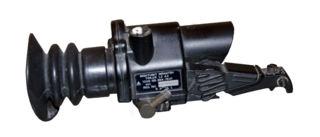 W
WThe SUIT sight is a 4× telescopic sight with tritium-powered illumination, utilised at dusk or dawn. The full name is the L2A2 Sight Unit Infantry Trilux. The sight is not designed as a sniper sight, but was issued to designated marksmen. The sight was mounted on the L1A1 Self-Loading Rifle or GPMG.
 W
WThe Sight Unit Small Arms, Trilux, or SUSAT, is a 4× telescopic sight, with tritium-powered illumination utilised at dusk or dawn. The full name of the current model is the SUSAT L9A1. The sight is not designed as a sniper sight, but is rather intended to be mounted on a variety of rifles and to be used by all infantrymen. A similar device is the Advanced Combat Optical Gunsight.
 W
WA swagger stick is a short stick or riding crop usually carried by a uniformed person as a symbol of authority. A swagger stick is shorter than a staff or cane, and is usually made from rattan. Its use derives from the vine staff carried by Roman centurions as an emblem of office.
 W
WUnmanned systems of the British Army is a list of all modern and in service remote and unmanned surveillance, reconnaissance, bomb disposal and combat systems of the British Army.
 W
WThe Wheelbarrow is a remotely controlled robot designed in 1972 for use by British Army bomb disposal teams operating in Northern Ireland, mainland Britain and Iraq. Over 400 have been destroyed in operation, and they are considered to have saved the lives of hundreds.